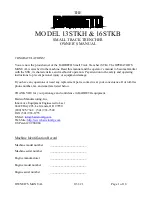
3 / 39
FISIOLASER IRD/IRD 2
INTRODUCTION
We will start by explaining the physical properties of laser in order to provide a
better understanding of how it works in a medical context.
Basically, laser is a system whereby energy contained in some substances is
transformed into
electromagnetic radiation
when stimulated electrically
.
Laser beam electromagnetic radiation can be produced in different parts of the
spectrum, including the visible spectrum, the ultraviolet spectrum (UV), the infrared
spectrum (IR), etc.
Before describing the laser process, we should explain some basic electromagnetic
wave terminology:
- Wavelength (
)
- Frequency (
)
- Period (T)
- Speed of light (c)
- Refraction index (
)
The
frequency (
, ni) is the number of oscillations the wave makes per second.
The formula relating these two parameters is :
c =
x
The minimum time interval between two successive points with the same phase is
the
period (T).
When the electromagnetic radiation (light) passes through a material with a
refraction index of
its velocity (
v
) is less than the
velocity of the light
in a
vacuum (
c
), and is given by this equation :
v = c/
This equation is used as the definition of the
refraction index
(rho):
=
speed of light in a vacuum/speed of light through the material =
c/v
The refraction index of gases, including air, is generally considered to be the same
as that of a vacuum
0
=1
.
The refraction index of many transparent materials in the visible spectrum is between
1.4 and 1.8. It is higher in the infrared (IR) spectrum and is between 2.0 and 4.0 .
PROPERTIES OF LASER LIGHT
“
Normal light”
(from the sun or a lamp) comprises different wavelengths, radiating
in all directions.
The phases of the different waves emitted from the source are not related to one
another.
On the other hand, laser radiation has some properties that do not exist in other types
of electromagnetic radiation :
1) Mono-chromaticity
: means that the laser has only one wavelength, and therefore
only one vibration frequency. It also has only one colour defined by the active
medium that produces it
.
In order to understand the term, we will look at “white
light” which is what the mind understands when all the colours of the spectrum are
seen together. When white light is passed through a prism it separates into all the
component colours
.
On the other hand, the laser beam is composed of only one of these colours .
2) Coherency
: is the property whereby all the photons emitted vibrate in phase
concordance .
The light from an incandescent lamp for example, is composed of different waves.
They propagate randomly without any order between their phases or between their
wavelengths.
Laser radiation on the other hand is composed of waves with the same wavelength
that leave at the same time and keep their phases constant in the direction of
propagation.
3) Collimation
: radiation is emitted from the laser in one direction only, and is
diffused with a definite angle of divergence (q) .
The angular diffusion of a laser beam is very small if compared to other sources of
electromagnetic radiation, since the divergence is in the order of milli-radians.
The divergence angle is the complete angle of opening of the laser beam (basically
its width).
The formula relating radians and degrees is :
360°= 2
Radians
(1 radian =57,3 °; 1 milli-radian = 1 mrad=0,057 ° )
The divergence of laser radiation is in the order of milli-radians.
The beam is practically always parallel and laser radiation can propagate for very
long distances.




































